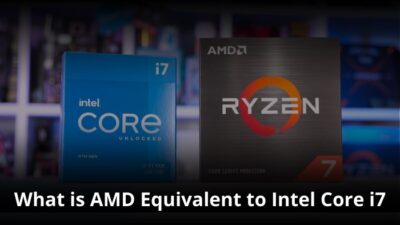Can you undo or redo any previous changes without changing the recent ones in text editors?
The answer is NO because you have to fix the last one first, and this method is known as STACK!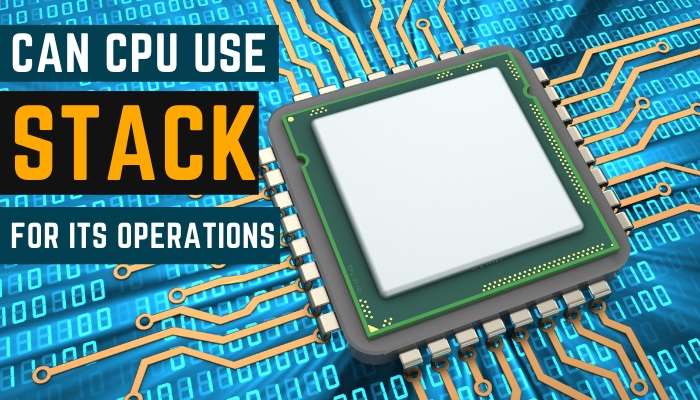
Likewise, the CPU also uses the stack for its operation, and its access method is called LIFO.
Users mailed me a lot to know about this stacking feature in the CPU. Concerning this, I came up with this article to give you in-depths of the stack feature and how it works.
So, let’s begin without any delay!
What is a Stack in a CPU?
A stack is an abstract data variant that includes a collection of elements. Specifically, it is a data storage structure that extracts the most, recently stored data. Hence, it’s called the LIFO (Last In First Out), and it’s one of the major features of computer architecture.
The stack is a bunch of memory locations for the registers that store the top-of-element address for the computers. By this, a stack is also called a memory containing an address register. And those registers are called Stack Pointer or SP.
However, the top element’s address in a stack is consistently affected by the SP. Arithmetic Logic Unit (ALU) operations are common in this stack organization, for this reason, both operands are always vital in the stack.
The stack pointer can add or remove any element from the stack. That’s why Push and Pop are the main two operations executed on the operators. These two operations get executed from one end only.
Before pitching into the stack operation, note that cache and register are a sort memory that plays a noteworthy role in the process. Though they are quite different.
Below are the main stack operations:
- Push: This operation inserts one operand to the top of the stack and also, decreases the stack pointer register. So, in a stack, the push implementation inserts the data word to a specified address at the top of the stack.
The push implementations are as follows:
//Store the data word’s specified memory address in SP, which is at the top of the stack.
SP ← (Memory Address)
- Pop: in the Pop operation, an operand gets extracted or deleted from the top of the stack, which results in increasing the stack pointer register.
The format for the pop implementations is as follows:
(Memory Address) ← SP
SP ← SP + 1 [SP incremented by 1]
To simplify this push & pop stack operation, let me give you a quick real-life example.
We all know what a spring-loaded tray dispenser is. If you have 6 plates and mark all of them from 1 to 6, then load all those plates randomly into the tray dispenser from the top.
Suppose, you inserted those plates in this sequence 3, 5, 1, 6, 2, 4. Therefore, you loaded the number 4 plate in the last and number 3 first. The fact is when you have to get any plate from the dispenser you must pull the number 4 plate first.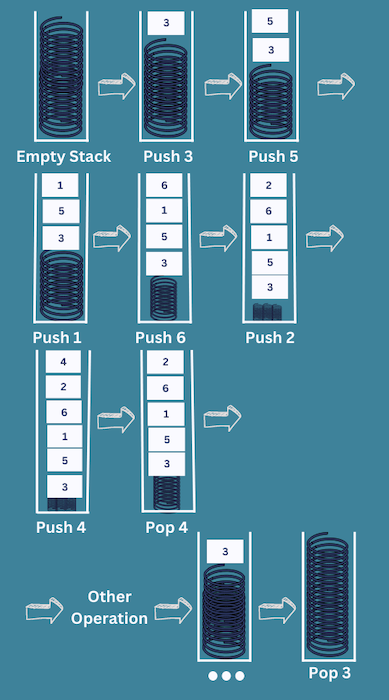
So, here, plate number 4 is the “Last In” plate and also the “First Out”. No matter how many plates you insert or extract, you have to pull the number 3 plate in the last. That’s how the LIFO or Stack feature works on any CPU.
Overall, the stack is a helper of the CPU to process instructions by queuing up the data and send them in order to get executed.
Register Stack & Memory Stack in Computer Architecture
In stack operations, you’ll find two types of implementations, which are Register & Memory stack. So, the register stack organizes the finite numbers of registers to store temporary data, whereas the memory stack gets implemented in the computer’s random access memory or RAM.
Register Stack
In this stack segment, a finite number of registers store temporary information or data words during executing a program. Here, the stack pointer register holds the address of the top element of the stack.
Consider the following figure’s 64-word register, where the stack pointer register contains a binary number. This binary number is the address of the stack’s top element. In this figure, A, B, and C these three elements located in the stack.
Here, element C is in the top position and the stack pointer (SP) holds its address in 3. When the pop operations start, element C will extract first from address 3, and then decrement the SP by 1. After that, the next element B will hold the top position and SP will now hold its address, which is 2.
Now, in that stack, it can push a new word, but before that, the stack pointer gets incremented by 1. And the new word is pushed to that incremented location. 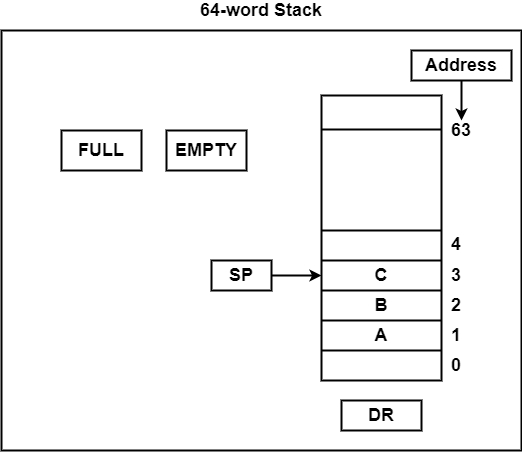
In a 64-word register, the SP includes only 6 bits because 26 = 64, and it can’t surpass 63 (In binary, decimal 63 is 111111). When the SP is incremented by 1, the result will become 0 because 111111 + 1 = 1000000, and SP can hold only the six least significant digits.
Similarly, when 000000 gets decremented by 1 the result becomes 111111.
However, if the stack is full, the one-bit register FULL will be set to 1. Correspondingly, the one-bit register EMTY will be set to 1 if the stack is null. The data register or DR holds the binary information which gets composed into or read out of the stack.
At the beginning of the operation, the stack pointer, Empty and Full is set to 0, 1, and 0 subsequently. A new element will add to the stack through push operation since the stack is not full.
The followings are the execution process of a push operation:
K[SP] ← DR // Writing element on the top of the stack.
If (SP = 0) then (Full ← 1) // Checking whether the stack is full.
EMTY ← 0 // Marking the stack is not empty.
After that, the SP gets incremented by 1, and the next higher word’s address is also stored in the SP. Now, the memory write operation inserts the data register’s word into the stack.
As a result, the first element is stored at address 1, and the final element gets stored at address 0. The stack will be full, and FULL will be set to 1 when the SP is at 0. This will happen only if the stack pointer was at location 63, after addition, the final item is stored at address 0.
When the address of the element is at 0, there won’t be any empty registers in the stack. Thus, the EMTY will be set to 0. Meanwhile, a new item will delete from the stack in case the stack is not empty (if EMTY = 0).
Below are the sequences of micro-operations, including pop operations:
SP ← SP – 1 //Decrementing the SP.
If (SP = 0) then (EMTY ← 1) //Checking whether the stack is empty.
FULL ← 0 //Marking the stack is not full.
After this operation, the stack’s top element will get read and transferred to the data register (DR), and that’s how the stack pointer is decremented. When SP reaches to 0, the stack becomes empty and EMTY get sets to 1.
So, This is the situation when the item in position 1 is read out and the stack pointer (SP) is deducted by 1.
Memory Stack
Another implementation of the stack is the memory stack. In this execution, a stack gets implemented in the computer’s random access memory (RAM) thanks to the tight integration of the CPU and RAM.
In the CPU, the stack executes its operations by assigning a block of memory to a stacking process and utilizing a processor register as a stack pointer (SP).
A computer’s memory area is divided into three parts: program, data, and stack. The pointer Program Counter (PC) stores the address of the next instruction in the program. Plus, the Address Register (AR), indicates an array of information.
Meanwhile, the stack pointer controls the location of the top element of the stack. So, the three registers that are related to the common bus are PC, AR, and SP.
Here, the PC reads the instructions during data fetching, AR reads an operand while executing stage, and SP pushes or pops an element from the stack. 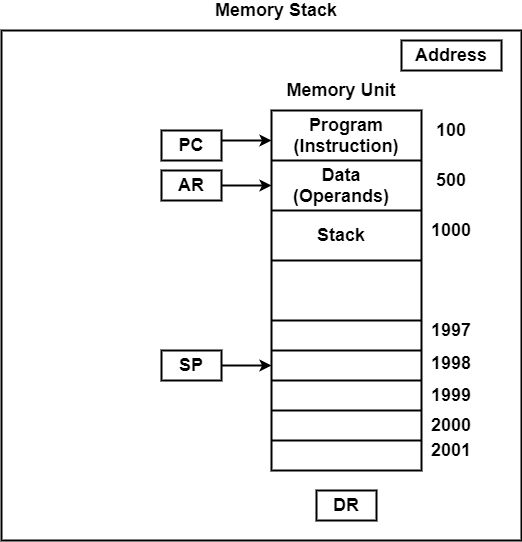
From the figure above, the stack pointer (SP) indicates the starting value in 2001. Next, the stack gets increased by decreasing the addresses. As a result, the first item is saved at 2000, then the next item is saved at the address 1999, and the final item gets stored at 1000.
As you know, the DR (Data Register) can read an element from or into the stack, and it can also apply a push operation to add a new item to the stack.
K ← SP [DR]
When it inserts another element, the SP is deducted by 1. It can also identify the location of the next word. The Memory Write Operation then inserts a word from the DR to the top of the stack. However, it can also delete an element from the stack. To do that, it applies the pop operation.
SP ← SP + 1
Next, the top element is read into the DR, and SP gets decreased to indicate the next item in the stack. At this time, two CPU registers will check the stack limit. Whereas, one CPU register controls the upper limit (1000) and the other one controls the lower limit (2001).
When the push operation is running, the stack pointer is matched with the higher limit to test whether the stack is full. Conversely, the SP gets matched with the lower limit to check whether the stack is empty, during the pop operation.
With everything said, the stack-based operation is a way to execute processes by the CPU.
Advantages & Disadvantages of Stack-based CPU Organizations
Stack-based CPU operations both have advantages and disadvantages. Among the benefits, this stack operations can solve any complicated arithmetic expression with competent computation. As for the disadvantages, the program size increases during the stack operations.
Here are the advantages & disadvantages of stack-based CPU organizations:
Advantages
- Stack operations can execute complex arithmetic expressions with efficient computation.
- The operand data get stored in the sequential memory locations, so instruction execution is faster in the stack.
- Instructions don’t have any address field in the stack-based operations, as a result, the instruction length becomes short.
Disadvantages
- The program size increase due to using stack.
- Memory stack operations use the memory, and it’s slower than CPU registers. Because memories have lower bandwidth and more latency than registers.
These are the basic advantages & disadvantages of a CPU’s stack-based operation.
FAQs
What are the disadvantages of stack-based CPU operations?
The main demerit of the stack is the program size increases while using stack operations. Plus, it’s slower because of using memory instead of registers for memory stack operations.
What are the main operations of the stack?
A stack mainly performs two types of operations, which are Push & Pop. The push operation inserts an element at the top of the stack, whereas the pop extract or delete an element from the top.
What is LIFO in a stack?
The term LIFO is Last In First Out is the main working procedure that the stack follows, and it’s one of the crucial access methods of the CPU.
Final Words
Now, you know, CPUs use the stack to perform the operations. In this article, I demonstrated what a stack is, and the way it operates. Additionally, the stack has two different types of implementation systems, which I have also shown briefly in this article.
Finally, you have a clear vision of stack-based operation in a CPU and how it works. However, for more info, do let me know by leaving a comment in the box below. See you again at the next one.
Good luck!


